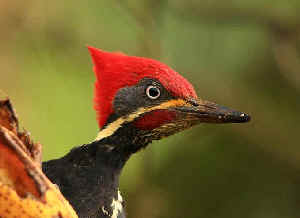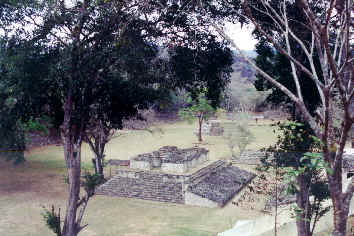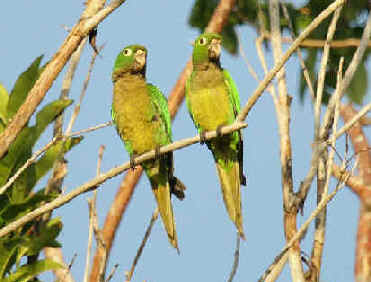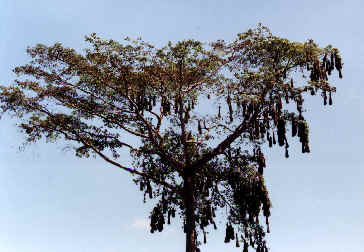
E-mail: font@focusonnature.com
Phone: Toll-free in USA 1-888-721-3555
or 302/529-1876
Website: www.focusonnature.com
 |
PO Box 9021,
Wilmington, DE 19809, USA E-mail: font@focusonnature.com Phone: Toll-free in USA 1-888-721-3555 or 302/529-1876 Website: www.focusonnature.com |
PAST
Tour Highlights
from some Focus On Nature
Birding and Nature Tours
in Honduras

Lineated Woodpecker
The
summaries that follow the links below are with the most-recent tours first.
For some tours there may be links for longer narratives.
There are links here to
UPCOMING TOUR ITINERARIES, and lists (some with photos) of BIRDS,
MAMMALS, BUTTERFLIES, MOTHS, and OTHER NATURE.
Some Previous Tours:
February 2007 March-April 2003 December 2002
Links:
Birds during FONT Honduras Tours A Complete List of Honduras Birds
Butterflies in Central America Moths in Central America
Mammals in Central America Marine Life of Honduras, Belize, & eastern Mexico
A Photo Feature of the Nature and Scenery of Honduras
Upcoming FONT Birding & Nature Tours in Central America

A Turquoise-browed Motmot
photographed during a FONT tour
![]()
Of the 700-plus species of birds recorded
thus far in Honduras, only one is endemic to the country. It's a hummingbird
called the Honduran Emerald, considered critically threatened by Birdlife
International, and "re-discovered" in 1988. We'll be going for it
during our upcoming the
![]()
HONDURAS
(northern & western)
- February 2007:
Link:
Birds
& Other Wildlife during our Honduras Tour in February 2007
The following account written by Armas Hill, leader of the tour, upon his return:
A FONT birding and nature tour
in February 2007 was in a country, Honduras, not known as much for such tours as
let's say Costa Rica, Trinidad, and others.
But, Honduras is a wonderful place
for such travel, with a variety of habitats to be explored including rain
forest, cloud forest, pine forest, grassland, and mangrove-lined estuaries.
During our tour, we visited each of the habitats just mentioned, each with its
set of birds.
Among the more than 200 bird species during the tour, we saw one that's
"resplendent", and another that's "lovely".
The Resplendent
Quetzal was in a cloud forest filled with the beautiful sounds of solitaires
and nightingale-thrushes.
The Lovely Cotingas that we saw in a
tree feeding on fruits. There were both male and female cotingas, about a
half-dozen in all. The male's a brilliantly bright blue.
It was a colorful day,
that day, for birds, also with chlorophonias, honeycreepers, tanagers,
toucans, trogons, and a selection of hummingbirds.
Yes, Honduras is a
good place to go for birds, and we'll be going back.
![]()
HONDURAS
(northern & western)
-
March/April 2003:
Link:
Birds & Other Wildlife during our Honduras Tour in March-April 2003
The following account written by Armas Hill, leader of the tour, upon his return:
To those of us now in the northern US, and elsewhere where winter has lingered this year, it can be said that the northbound birds of spring are coming - yes, they really are!
During our March/April 2003 birding tour in the Central American country of
Honduras, we were, last Saturday morning, having breakfast right along the Caribbean coast, in an outside restaurant atop a bluff above the beach.As we looked out toward the sea, there was a constant stream of birds in flight, from right to left, that is heading north. Barn and other Swallows, Chimney Swifts, and Eastern Kingbirds were all in the procession. There were hundreds and hundreds, even probably thousands of birds. In the trees around the restaurant, Rose-breasted Grosbeaks and both Baltimore and Orchard Orioles came and went. They, too, heading north to the forests, pastures, and other habitats in North America. The recent weather in the North, notwithstanding, the birds of spring will be there on schedule.
As we left that restaurant that morning, for the van, an oriole was singing in the tree above. We could see it was a bird that would stay in the area, not having the urge to migrate north. The fine song came from a Spot-breasted Oriole. There was a pair of them in the tree.
Honduras is a land of Orioles. And the related Oropendolas.
At the site of the
Mayan city of about a thousand years ago, Copan, the trees were filled with the bright orange and black plumages of orioles. Most were the Altamira, a large oriole that used to be called Lichenstein's. The species resides as far north as the Rio Grande Valley of southern Texas. Other orioles at Copan were the Streak-backed and Spot-breasted, both Central American species, in addition to the Baltimores and Orchards that were there by the temples.
Mayan Ruins of
Copan
(Photo by Marie Gardner during a FONT tour)
During the day, at Copan, we saw an estimated couple hundred orioles. How nice for trees to be filled with such color.
Also in those trees by the temples, there were Pink-throated Becards (also common), Golden-fronted and other Woodpeckers, Tityras, and Motmots (the Turquoise-browed another splash of color!). In the trees, there were smaller splashes of color, in the form of warblers. There were many Magnolias.
At the top of the temples, we found
ourselves eye-to-eye with White-fronted Parrots and Aztec (or Olive-throated)
Parakeets.

The next day, as we ascended a nearby dirt road higher into the mountains, we encountered yet another oriole, the Yellow-backed (overall, yellow and black), and it's all-black cousin the Yellow-billed Cacique (it, all-black except the bill). Also yellow-and-black were Black-headed Siskins and Lesser Goldfinches. In the pine trees, there were Grace's and Olive Warblers that would stay, Black-throated Greens that would go to eastern North America, and a Red-faced Warbler that would likely go north to Mexico. Overhead, that day, a flock of Chestnut-collared Swifts kettled, and a group of Broad-winged Hawks continued on their way.
Earlier I mentioned Oropendolas, large icterids related to Orioles. In the Honduran hills, we came across a flock of Chestnut-headed Oropendolas. They tamely stayed by us. Not far away there were Green Jays and Brown Jays, the latter more obvious, certainly more noisy.
In the lowlands, Montezuma Oropendolas
were by their nests that dangle like stockings. At one particular place in that
area, in a very large tree, there was an big, active colony of these birds, big
themselves, coming and going, with their bright yellow tails. Their loud
gurgling sounds were constant.


But even so, in the background, we could hear the Little Tinamou. And we certainly had no trouble seeing the brightly-colored Keel-billed Toucans in the air and the smaller, yet also also colorful, Golden-hooded Tanagers in the trees. Brown-crested Flycatchers were also nesting in a tree near the oropendolas, where also there were Sulphur-bellied and Piratic Flycatchers staking claims to their spots. The latter two flycatchers are migrants, that would not go to on to North America. They came from South America.
There's a city in North America, well-known to many, called "Miami". In Honduras, along the Caribbean coast. there's another place with the same name, but very different. The
Honduran "Miami", at the tip of a narrow spit of land between the sea and a large bay, is a row of wooden shacks with thatched-roofs. The people who live there, Black Caribs known as "Garifunas" are fishermen who walk out into the surf at the inlet with nets and bait in their hands. Above them, when we were there, were Royal and Sandwich Terns, attempting their catches. And Magnificent Frigatebirds, dipping to water's surface, to get theirs (As you know, frigatebirds can not get wet). It was quite a sight at the end of long white beach, otherwise devoid of people, but certainly filled with shorebirds whimbrel, plovers, sanderlings and sandpipers.Along the road between the beach and the highway (where again there were no people, only birds), we had an enjoyable end-of-a-day. As twilight fell, a lone Yellow-headed Amazon (a large parrot) flew by. A Bare-throated Tiger-Heron flew along a channel. A wild Muscovy Duck flew up and lit in a tree. Egrets, of various kinds, were in the sky, heading to their roosts. As many as 15 Lesser Nighthawks were flying about against that beautiful sky above us, just after sunset. From a nearby marsh, Gray-breasted Wood-Rails gave their raucous evening calls. Then, as it was getting dark, a half-dozen or so Pauraques gave their calls, as did one Yucatan Nightjar, from the scrubby ground not far away. The Yucatan Nightjar (yes, a bird that occurs almost entirely on the Yucatan Peninsula) was only discovered to be in Honduras about 10 years, first found not far from ours, in a similar habitat.
Other highlights of the tour included both Fulvous and Black-bellied Whistling-Ducks (at one place about a thousand of the latter together), Limpkins by a lake, and hummingbirds, of many kinds, feeding in "inga trees" in bloom.
Honduras
is a land that begs to be birded. Many places, pristine and undeveloped.
![]()
HONDURAS
(northern & western) - December 2002:
a
lovely land of Orioles & Oropendolas,
and with a bird named "Lovely"
(and how many birds in the world are given that adjective?)
Link:
Birds & Other Wildlife during our Honduras Tour in December 2002
The following account written by Armas Hill, leader of the tour.
In early December 2002, FONT conducted its first birding tour in the Central American country of Honduras, located between Guatemala and Nicaragua. There have been numerous FONT birding tours previously elsewhere in Central America, in Guatemala, Belize, Costa Rica, and Panama. There were 6 of us on the tour, and we had a fine Honduran birder with us, Jorge.
In all, we encountered 232 species of birds in 6 days. Our Honduran travels were in the northern sector of the country.
We went into highlands, with both deciduous and coniferous forest, near the Guatemalan border, where Mayans lived, in former times, around their city of Copan.
We visited a large lake called Yojoa, edged by reeds, and further out by rugged hills. Birding there was by boat, and then in some fine forest by the shore.
Along the Caribbean coast, we ventured, by 4-wheel drive, to a beach called Miami. It was not at all like its famous namesake. Only a very few people lived there, in some shacks, among palm trees, on a narrow strip of land between the Caribbean and a large lagoon. On the beach, there were many birds and usually no people where the surf met the shore. Plovers and sandpipers occupied the sand. Terns, pelicans, frigatebirds, and herons rode the breeze. By boat, we ventured along channels in the mangroves and then across the lagoon, to a place where birds were many and people were few. There were only a couple fishermen in small wooden boats. Our boatmen turned off the engine, and walked by us in the water, as we observed birds ranging from the largest stork, the Jabiru, to a Peregrine Falcon that eyed us but never moved, as we watched it (the bird after all had come a long way to be there).
The next day we were in a tropical forest, by a large botanical garden, another place where birds were many. Some greenish, as the foliage, but most with vivid bright colors.
And the last place we visited was about as much like paradise as a place can be (except when we get to "paradise", I don't expect the trails to be steep. Birdy, yes, steep, no). We were on the forested Caribbean slope. We could observe at ground level along the trails (no, they weren't all steep), and from the canopy on comfortable observation towers. Staying still for a while, at the bottom or top of the forest, enabled us to observe the birds as they came and went. Up high, toucans and tityras flew. Down below, hummingbirds bathed and flycatchers and warblers fed.
Honduras has the most forest of any Central American country, about 40 per cent of its territory. In much of the country, there are no roads. There's a wildness to the place that provides an appealing aspect to the birding. And the prospect of maybe seeing a creature of the "wild". Where we were on the Caribbean slope, along the rocky edge of a rushing stream, two weeks before our visit, others (who were lucky) saw a jaguar basking in the sun. When it saw them, it slinked (or is it slank?) away into the deep, green forest.
The remaining portion of this narrative that follows relates to some of the
birds of Honduras. Not many birders
visit Honduras (as they do Costa Rica or Panama), but there is good birding:
Never could as many orioles be imagined in one area as we saw during one day around Copan, in the highlands. Brightly colorful, there were at least a couple hundred orioles of 5 species Altamira, Streak-backed, Spot-breasted, Baltimore, and Orchard. In one large tree, at one time, there must have been nearly fifty, with all five of these species represented. That tree, in a way, nature's version of one with ornaments, as were trees in the nearby Honduran town plaza, decorated with lights for the upcoming Christmas holidays.
Two species of Oropendolas (icterids larger than orioles) were seen in large numbers during our tour the Montezuma and the Chestnut-headed. On one occasion, as we rode through a forest and coffee finca, oropendolas, with their bright yellow tails, were flying away from us in all directions. Montezuma Oropendolas provide not only a fine sight; their gurgling is a fine sound.

Montezuma Oropendola
From a high observation tower in a forest we visited on the Caribbean slope, Montezuma Oropendolas, though obvious, were not foremost among the birds we saw. Even toucans, as gaudy as they are, became mundane. Tityras (of 2 species) perched at tree-tops were fine, and an eye-level look at a colorful Golden-hooded Tanager was tremendous. As was a look, just below, in flowers, at a beautiful feeding hummingbird called the Purple-crowned Fairy. But the "top honor" went to a startling, bright blue bird, that only sat in a tree across from us. All the bird had to do was appear. It was a male Lovely Cotinga.
There are 3 such striking blue, actually turquoise, cotingas in Central America. One is called the Turquoise Cotinga. In Costa Rica, it's been seen by some atop a bare tree on the property of the famous ornithologist, Alexander Skutch. The other, in Panama, is called the Blue Cotinga. But this bird in Honduras, as turquoise blue as the others, is named the Lovely Cotinga. And not many birds in the world have been given that adjective.
Also lovely were hummingbirds elsewhere in that forest, that during the afternoon, came to bathe at a small pool of a little stream. They were hermits and emeralds. The hermits an overall cinnamon color, the male emerald a vivid bright blue and green with a long tail, the female green and white. The emeralds hovered at the water; the hermits dipped into it. Although the beauty of such nature has been the same for a long time, the names and taxonomy ascribed to the species have changed the Fork-tailed Emerald is now the Salvin's. And what has been the "Little Hermit" is now called the Stripe-throated Hermit. What has been in Central America the "Long-tailed Hermit" is now called the "Long-billed Hermit".
One day, near
Lake Yojoa, was a good one for us for owls. A bird that we've
called for years the Ferruginous Pygmy-Owl, now called in Central America
the Ridgway's Pygmy-Owl, appeared nicely in the open on a upper tree
branch. We enjoyed two such sightings that day. During our morning walk, in an
open area by the lake, we were fortunate to see two Striped Owls at once,
a male and female, "hidden" in a big bush. At a good angle, not so
hidden. We saw them well.

Ferruginous Pygmy-Owl
(photo courtesy of Dick Tipton)
During an late afternoon boat-ride on the lake, waterbirds were numerous. The Limpkin was particularly enjoyed.
During another boat-ride, another day, on a large coastal lagoon, after seeing some Boat-billed Herons in mangrove trees, we thought there might be spoonbills and who knows what ahead us. Yes, there was Roseate Spoonbill, but it was dwarfed on the shoreline by the lone Jabiru, as it walked about also dwarfing White Ibises, egrets, terns (of 5 species), skimmer, and whatever else it happened to pass.
Not so dwarfed, however, were 5 White Pelicans. Brown Pelicans are common in that area along the Honduran coast of the Caribbean. White Pelicans are very rare. Both species were together. When you travel and bird, you never really know, beforehand, what you're going to see.
One particular sight for us that was wonderful to see, during the tour, was when 4 male White-collared Manakins (with their striking yellow, black, white, and green attire) were together, displaying, hopping up and down, and snapping their wings, in clear view, not just by us, but by both Golden-winged and Blue-winged Warblers that, for some reason, were attracted to also observe the performance.
On another occasion in that forest, that morning, 2 Yellow-bellied Tyrannulets displaying (with wing-lifting) on an open branch, attracted an agitated Magnolia Warbler.
It's nice to see our "summer Warblers" in a different environment, particularly the dapper Hooded Warblers, and the Kentucky Warblers that when south take on the ways of insect-eaters such as antbirds and foliage-gleaners.
Some last highlights of our tour to note included our looking up into trees above us in a forest to see about a dozen Shining Honeycreepers, bright blue, with even brighter yellow legs.
Or, to look into the sky, from along a road in the countryside, to see that one of the Turkey Vultures was actually a very-similar Zone-tailed Hawk.
Or, by the Mayan ruins, to see a Motmot, with it brilliant blue crown, and another, a little later, with its bright turquoise brow.
A third motmot, during our tour, had neither. But it was wonderful to find in the forest, a Tody Motmot, sitting on a branch a short distance from us.
Not seen, oddly, during our tour (even with all we saw) were a House Wren, a Rufous-collared Sparrow (in the highlands) or a Bananaquit! Now, how's that for a good tour?